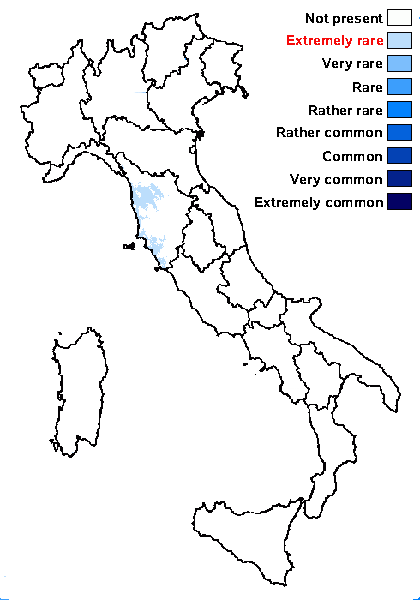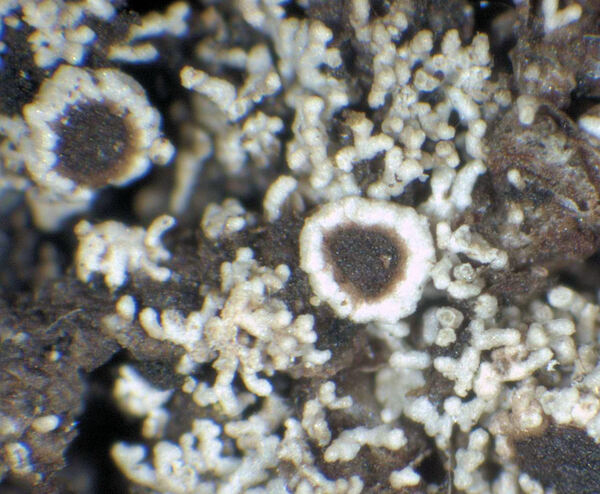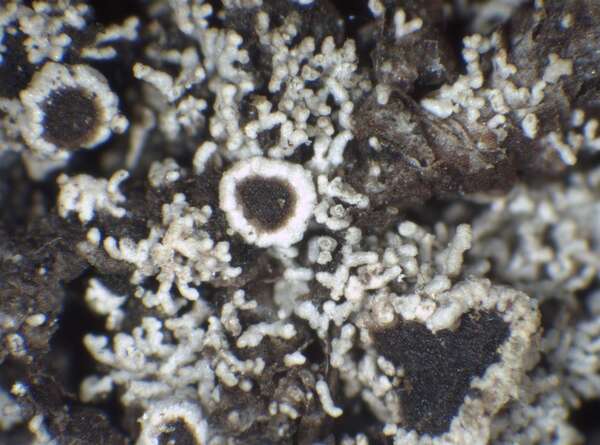Rinodina isidioides (Borrer) H. Olivier
Mém. Soc. Nat. Sc. Nat. Cherbourg, 37: 186, 1909. Basionym: Parmelia isidioides Borrer in Hooker & Sowerby - Suppl. Engl. Bot., 3: tab. 2808, 1843.
Synonyms:
Distribution: C - Tosc.
Description: Thallus crustose, episubstratic, whitish or grey-white, appearing subfruticose, as it almost entirely consists of numerous, slender, cylindrical-coralloid, up to 0.3-0.4 mm long and c. 0.1 mm thick isidia which are often brownish at top. Apothecia lecanorine, scattered, sessile, (0.5-)0.7-1 mm across, with a brown to blackish brown, concave to flat disc, and a thick, entire, crenulate or isidiate, persistent thalline margin. Thalline exciple 70-110 μm wide laterally, corticate; proper exciple colourless, thin, expanding in upper part; epithecium pale orange- brown; hymenium colourless, 100-150 μm high; paraphyses coherent, 2-3 μm thick at mid-level, the apical cells 3-4 μm wide; hypothecium colourless. Asci 8-spored, clavate, the K/I+ blue tholus penetrated by a faintly amyloid apical cushion with parallel or diverging flanks, the wall K/I-, surrounded by a K/I+ blue outer layer, Lecanora-type. Ascospores 1-septate, brown, ellipsoid, (17-)20–30(-34) x (10-)12-16(-18) μm, Pachysporaria-type, with a well-developed torus and ontogeny of type A (apical wall thickening after the early septum formation). Photobiont chlorococcoid. Spot tests: thallus K+ yellow, C-, KC-, P- or P+ faintly yellow. Chemistry: cortex with atranorin, medulla with variable amounts of zeorin. Note: a mild-temperate, Mediterranean-Atlantic species found on rough bark, more rarely on epiphytic mosses in ancient, undisturbed forests. It is included as “Critically Endangered” in the Italian red list of epiphytic lichens (Nascimbene & al. 2013c).
Growth form: Crustose
Substrata: bark
Photobiont: green algae other than Trentepohlia
Reproductive strategy: mainly asexual, by isidia, or isidia-like structures (e.g. schizidia)
Most common in areas with a humid-warm climate (e.g. most of Tyrrenian Italy)
Commonnes-rarity: (info)
Alpine belt: absent
Subalpine belt: absent
Oromediterranean belt: absent
Montane belt: absent
Submediterranean belt: absent
Padanian area: absent
Humid submediterranean belt: absent
Humid mediterranean belt: extremely rare
Dry mediterranean belt: absent

Predictive model
Growth form: Crustose
Substrata: bark
Photobiont: green algae other than Trentepohlia
Reproductive strategy: mainly asexual, by isidia, or isidia-like structures (e.g. schizidia)
Most common in areas with a humid-warm climate (e.g. most of Tyrrenian Italy)
Commonnes-rarity: (info)
Alpine belt: absent
Subalpine belt: absent
Oromediterranean belt: absent
Montane belt: absent
Submediterranean belt: absent
Padanian area: absent
Humid submediterranean belt: absent
Humid mediterranean belt: extremely rare
Dry mediterranean belt: absent

Predictive model
 Index Fungorum
Index Fungorum
 GBIF
GBIF




